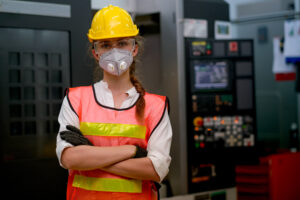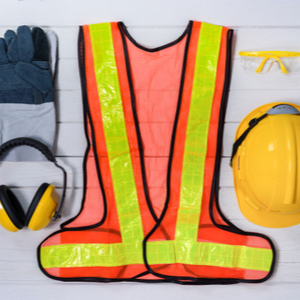Finding a meaningful career path is important, and there are many variables that can make for a dream job. Excellent pay, personal satisfaction, professional recognition, job security, and a good future employment outlook are just a few of the things that contribute to finding a job you love.
A career as a public health engineer may meet the criteria for meaningful work. It’s a rewarding career that impacts public health in the community by protecting and promoting health. Read on to learn more about what a public health engineer does and to see if a career in public health engineering may be a fit for you.
What is a public health engineer?
Public health engineers are public health professionals that work to maintain and manage a healthy environment within the community. Through the design of systems and development of policies and procedures to help prevent injury and sickness, public health engineers are on the job when it comes to protecting and promoting health.
A public health engineer often collects and reviews data, lab reports, and input from other agencies to enhance health and safety. They often evaluate sanitation conditions in places such as hotels, restaurants, parks and other meeting places. Healthy air and water conditions are also monitored by public health engineers.
All public health engineers solve problems that relate to public health, environmental health, and management of waste.
Where do public health engineers work?
Public health engineers work in a wide range of organizations and always are working to solve problems to promote and protect the health of the community, which includes people, animals, and the environment. Public health engineers work in many different industries, including universities, laboratories, utility companies, refineries, manufacturing companies, and government agencies. Some experienced public health engineers become consultants, assisting private industries and government agencies by helping them to manage their programs and facilities.
What is an average day like for a public health engineer?
Public health engineers can have a wide range of tasks and projects they are working on. Often, they will be visiting different locations and facilities performing inspections to ensure that both local and federal health and safety standards are met. These public health professionals also keep an eye out for problem areas that could be improved to further ensure health and safety.
Public health engineers also create reports and work to develop systems for improving public health and reduce public health risks. Enforcing local, state, and federal public health regulations that relate to public water supply systems, waste disposal, sewage, water treatment, and more come under their domain. They may even find themselves with government officials, working together to improve public health by reducing health and safety risks.
What kinds of duties and responsibilities might a public health engineer have?
Public health engineers may be working to ensure water safety at a water treatment facility, working with civil engineers to troubleshoot and improve city sewer treatment systems, or working with manufacturing companies to ensure their manufacturing processes are not adversely affecting public health and the environment. Public health engineers may work with health departments of the federal government’s Center for Disease Control (CDC), the Environmental Protection Agency (EPA), or Health & Human Services (HHS) with great responsibilities to ensure the health and safety of the population and the environment. Some public health engineers may have responsibilities with humanitarian organizations, ensuring public health in vulnerable populations.
What other things do public health engineers often do?
According to the Bureau of Labor Statistics (BLS.org), these health and safety professional often perform duties such as:
- Maintenance and application of knowledge of current public health and safety policies, regulations, and processes
- Reviewing plans and specifications for new machinery and equipment, ensuring that they meet safety requirements
- Identifying and correcting potential hazards through inspection of facilities, machinery, and equipment
- Evaluating industrial control mechanisms and their effectiveness
- Ensuring that buildings and products are in compliance with health and safety regulations, and remedying problems after inspections
- Directing the installation of safety devices
- Reviewing employee safety programs, then recommending and carrying out improvements
How does one become a public health engineer?
Those aspiring to enter the public health profession as a public health engineer typically have either a bachelor’s degree or master’s degree, with few exceptions. Choosing your major in college will help pave the way into this exciting career. Many get their bachelor’s degree in engineering, and acquire a specialization in environmental health. To enter this field as an entry-level public health engineer, following graduation, one must gain a minimum of two years of on-the-job experience in a public health or environmental health field, or other additional training. Also, most states require licensure.
Commonly, those aspiring to public health engineering study public health or environmental engineering. These programs will offer the standard courses that ensure knowledge in the areas that public health engineers must be well-versed in. Courses will include classes in engineering drawing, mechanics, materials, and engineering fundamental theories, as well as geology, civil or electrical engineering, and surveying. Students can expect an introduction to fluid, soil, and solid mechanics. Bring your calculator to learn calculus, analytical geometry, and other advanced math classes. Students enjoy electives in such subjects as structural analysis, hydrology, transportation engineering, and project management.
In addition to traditional classroom experiences, some programs require internships or other experiences outside of the classroom. These are opportunities for students to investigate areas of their interest and network, giving direction to future aspirations.
How does one become a licensed engineer?
To become licensed as an engineer, one must work under a licensed Professional Engineer (PE) for at least four years. In addition to work experience, an engineer must pass two intensive competency exams to become licensed as a Professional Engineer (PE) through their state’s licensure board. To retain the credential as a Professional Engineer (PE), continued education requirements must be met and the PE must continue to improve and enhance their skills and knowledge throughout their career.
Clients and employers recognize the PE credentials and the effort in education and work experience required to earn it. Employers know they can trust the ability and skill of a PE, and they know a PE can take responsibilities that could take them to higher levels of work.
Earning this credential is worth the effort, with PE’s combining specialized skills and knowledge with high standards for quality and ethics. PE’s help ensure health and safety of the population, allowing people to live healthier and better lives than ever before.
Is it always a “straight track” to becoming a public health engineer?
While some people focus on becoming a public health engineer from the beginning, it is not unusual to enter the field less directly. Some find that experience from other jobs will help them to become a public health engineer. Some public health engineering jobs actually require experience in other roles, such as project engineering. It is not uncommon for public health engineers to have previous employment experience as engineers or project managers prior to entering the field of public health engineering.
Is a career in public health engineering routine?
While, like any career, there are many routine aspects, public health engineers sometimes have to work in challenging situations. Public health engineers should be prepared to work in challenging conditions, which may include working in the field under sometimes difficult social, weather, or environmental circumstances. They may have to deal with poor sanitation conditions, environmental issues like insect and rodent infestation problems, unsafe buildings, and dangerous chemicals, to name a few demanding and less routine situations. Public health engineers have to work with these and more problems in the field, and likely welcome some routine from time to time.
What characteristics do public health engineers often have?
Although education and experience go a long way in making someone a successful public health engineer, these professionals often have some personal characteristics in common. Most have very strong problem-solving skills that enable them to troubleshoot and find solutions. Problem-solving skills promise to have a direct impact in their ability to perform well under pressure as a public health engineer.
As in many careers, strong communication skills are necessary to perform the job well. Written and oral communication skills enable public health engineers to prepare meaningful reports, speak confidently to groups and individuals, and write succinct emails.
A public health engineer’s close attention to detail enables them to identify problems quickly, and then fix the problem. Having a strong ability to remember things such as codes, health regulations, and other details may be vital to a public health engineer’s success in the field. These characteristics in a public health engineer can help to ensure a secure and effective career in public health.
What do employers look for in a public health engineer?
Employers looking for good employees always want to find honest and hardworking employees, and public health engineering is no different. Employers look for people with practical experience and knowledge. Entry-level job seekers will tip the odds in their favor with practical experiences while in school, such as internships. Employers are looking to improve the health and safety of the community with knowledgeable public health engineers that can help them reduce costs while they’re at it.
What are some similar occupations to public health engineering?
According to the Bureau of Labor Statistics (BLS.org), careers that have some similarities to public health engineering include: industrial engineering, fire inspection, mining and geological engineering, occupational health & safety technology, and construction & building inspection.
How do public health engineers protect health and safety in the workplace?
Workplace safety is an important area of public health engineering. Public health engineers develop policies and procedures, and design systems to protect employees from illness, injury, and property damage. They make sure that chemicals, machinery, furniture, computer software, and other things in the workplace do not cause harm.
Public health engineers investigate workplace accidents and injuries, determining their cause and whether they could be prevented in the future. In addition, they assess the corrections made to remedy any violations found during health inspections.
How much do public health engineers get paid?
The median wage is the wage that half the workers in an occupation earned more than and half earned less. The median annual wage for all workers in all occupations in the U.S. in May 2020 was $41,950. The median annual pay for health and safety engineers in May 2020 was $94,240. This is obviously higher than the average for all occupations, but the amount someone is actually paid as a public health engineer depends on their location, education, work experience, special training, and more.
What is the job outlook for public health engineers?
According to the Bureau of Labor Statistics (BLS.org), the job outlook for health and safety engineers is average when compared to all other professions, with a four percent increase anticipated from 2019 to 2029.
What is the professional organization for public health engineers?
The professional organization for those in the field of public health engineering is the Society of Public Health Engineers. Professionals enjoy the benefits of these organizations for their networking and professional development opportunities, among other things. Other professional organizations that are related to public health engineering are the American Society of Safety Professionals and the National Society for Professional Engineers.
By Carol Dolan BS RN BSN CDCES:
April 2021
Carol graduated with her BS in Nutrition from Montclair State University and her BSN in Nursing from Rowan University. She is a Certified Diabetes Care and Education Specialist (CDCES) currently working with adults and children living with diabetes in both outpatient and inpatient settings.
Related Resources:






